World Bank clarifies air pollution in Tehran: Health costs, sources, policies
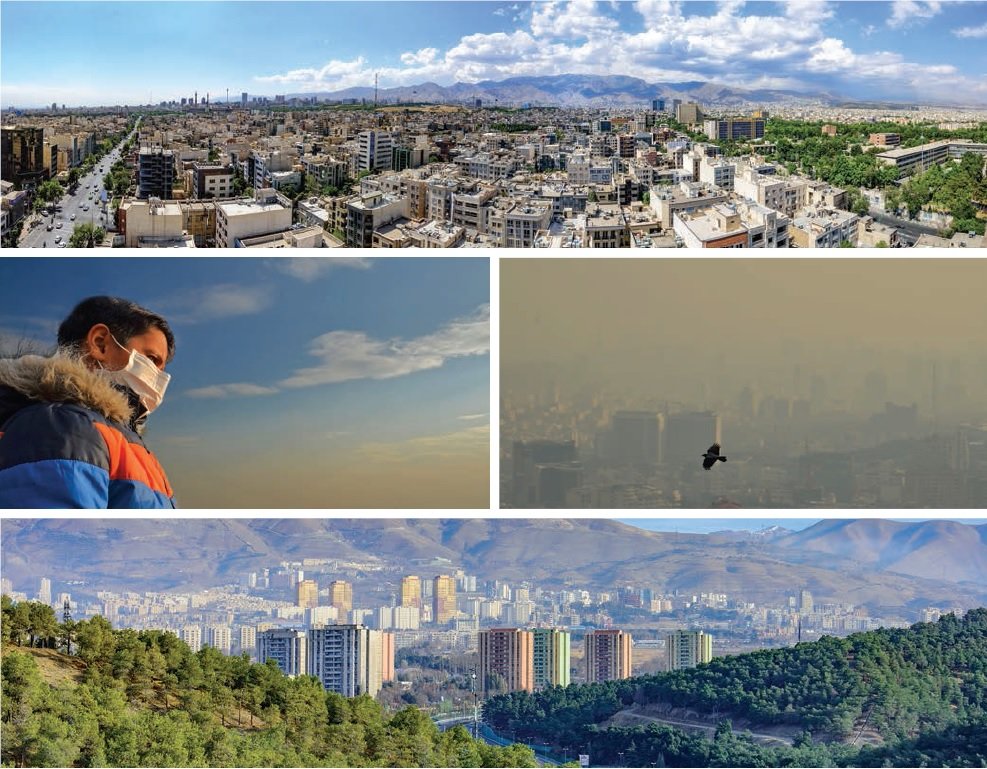
TEHRAN — Industrialization and urbanization have worsened environmental health risks and pollution, especially in developing countries.
According to a report by World Bank published in April 2018, there are more than 17 million vehicular trips per day in Tehran, and many of the vehicles have outdated technology. Thus, the air in Tehran is amongst the most polluted in the world.
World Health Organization (WHO) estimates that 12.6 million people die from environmental health risks annually. Air pollution has become the fourth highest risk factor for premature deaths as one in 10 deaths worldwide can be linked to air pollution exposure. Though the challenge of pollution is a global one, the impacts are overwhelmingly felt in developing countries. About 95 percent of adults and children affected by pollution-related illnesses live in low and middle-income countries.
Tehran, the capital of Iran, is located in the north of the country with a population of about 8.5 million. The population can reach over 12.5 million during the day, with people from nearby cities commuting daily to Tehran for work.
Topography and climate add to the pollution problem. Tehran is at a high altitude and is surrounded by the Alborz Mountain Range, which traps polluted air. Temperature inversion, which is a phenomenon particularly occurring during the winter months, prevents the pollutants from being diluted.
However, the study suggest that rapid population growth (partially due to migration from other cities), industrial development, urbanization, and increasing fuel consumption are pressure points for clean air in Tehran. To design an effective approach to air pollution management, it is important to diagnose the problem, determine its sources, and identify affordable and sustainable solutions.
Tehran, one of the most polluted cities worldwide
The study asserts that Tehran is one of the most air polluted cities in the world. Tehran is ranked 12th among 26 megacities in terms of ambient PM10 levels. After Cairo, Tehran is the most polluted non-Asian megacity. In 2016, the annual ambient level of PM10 was estimated at 77 micrograms per cubic meter. This is almost four times the WHO’s recommended threshold of 20 micrograms per cubic meter.
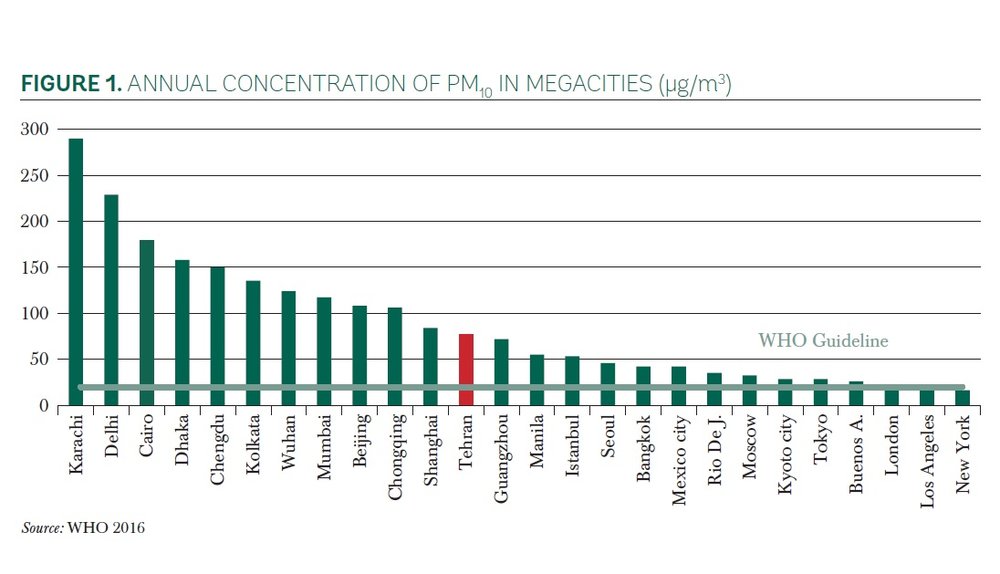
Additionally the annual mean concentration of PM2.5 in Tehran was 32 micrograms per cubic meter in 2015-2016, more than three times the national standards and the Air Quality Guideline of the WHO, which are 10 micrograms per cubic meter. These thresholds are set because there are close linkages between PM exposure and health mortality and morbidity effects, and the health effects are quite severe if these thresholds are surpassed.
Mortality and morbidity
Using the Global Burden of Disease (GBD) methodology and Integrated Exposure-Response (IER) functions, as outlined by the recent World Bank-Institute for Health Metrics and Evaluation (IHME) publication the research indicates that slightly more than 4,000 people die prematurely from ambient PM2.5 air pollution in Tehran per year.
It is estimated that reducing ambient PM2.5 concentrations to levels comparable to those of London (20 micrograms per cubic meter) would prevent about 1,300 premature deaths per year; and to levels comparable to those of New York City (15 micrograms per cubic meter) would prevent about 2,000 premature deaths per year. Most PM2.5 originates from mobile sources (i.e., transport). Reducing traffic emissions alone by half would prevent about 750 premature deaths per year.
Furthermore, air pollution is a major environmental risk factor for morbidity in Iran including diseases such as asthma, lung cancer, ventricular hypertrophy, Alzheimer’s and Parkinson’s diseases, autism, and retinopathy. High PM2.5 days lead to increased admissions to the emergency department, particularly for respiratory problems in Tehran.
Aside from respiratory problems, analyzing hospital admission and diagnoses in Iran also showed that air pollutants had a high correlation with acute strokes; and that long-term increases of PM2.5 were related to ischemic strokes. A study looking at around 300 women in Tehran, and evaluating the correlation between ambient air pollution and spontaneous abortions in the first-trimester, found that there is also heightened risk of spontaneous abortion associated with increased PM levels.
Economic burdens of mortality and morbidity
The economic costs associated with air pollution in Tehran are estimated at $2.6 billion per year. Mortality and morbidity due to current level of air pollution in Tehran. The estimate only considers human health effects, and therefore underestimates the total economic cost from air pollution. The total economic damage from air pollution would be much higher if one accounted for other impacts such as reduced agricultural productivity; reduced visibility; long-term damage to cultural sites and infrastructure; reduced quality of life; and education-days lost because of closed schools.
Reduction of PM2.5 ambient air pollution to concentration levels comparable to Seoul, South Korea, would result in avoided economic costs of about $400 million per year for Tehran. A further decrease to concentration levels comparable to those of Mexico City would result in additional avoided costs of about $300 million per year; to London levels would avoid an additional $400 million; and4 to New York levels an additional $500 million. Overall, reducing air pollution concentration levels comparable to those of New York City would save the Tehran economy about $1.6 billion annually in avoided economic costs. These avoided costs can be used a low estimates for the benefits of pollution reduction, which may be compared to the costs of pollution policy actions.
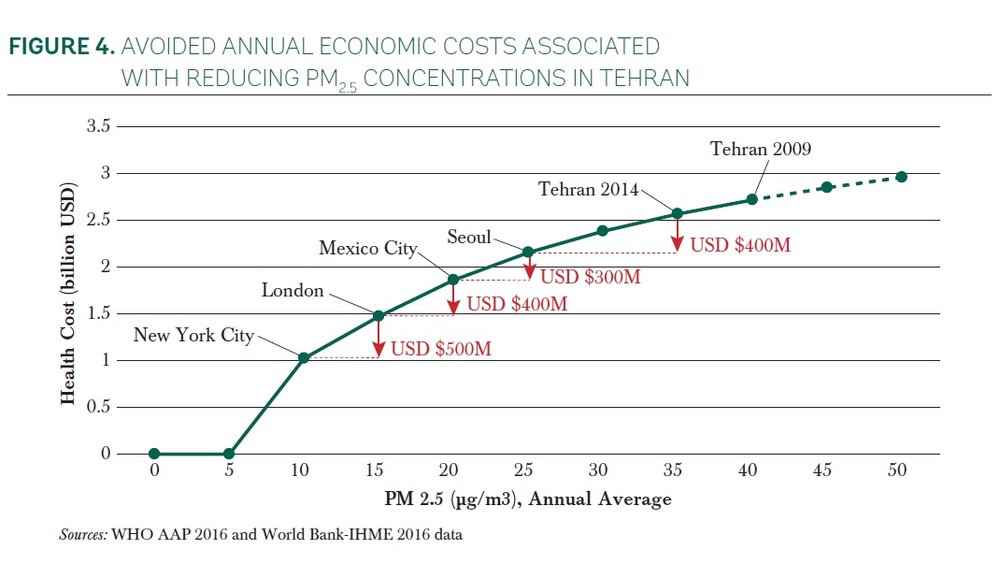
Contributor to ambient PM air pollution
The largest share of PM emissions, roughly 70 percent, originates from mobile sources i.e. vehicles. The remainder stems from non-traffic related emissions: 20 percent from energy conversion (including refineries and power plants), 7 percent from industries, 2 percent from household and commercial sources, and 1 percent from gas terminals.
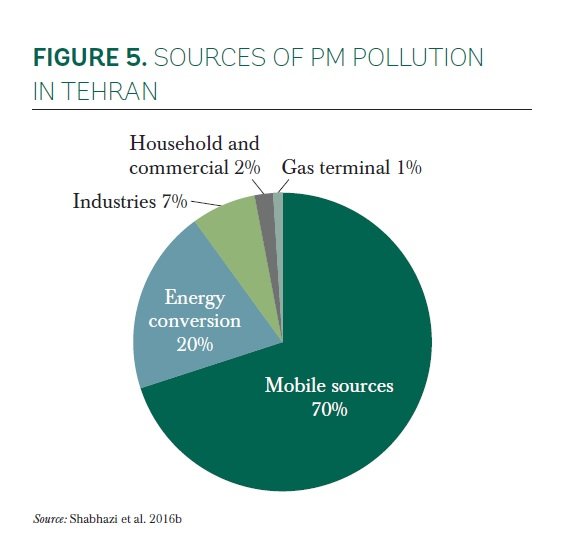
PM2.5 from natural origins such as dust and sand contributes to about one-in-four particles in Tehran. Prevailing winds from west of Tehran bring dust storms either from other areas near Tehran (including a desert near Tehran) or from even from neighboring countries.
Cars, the most abundant; heavy-duty vehicles, the most polluting
There are about 4.24 million vehicles in Tehran. Cars are the largest vehicle type, with a total fleet of 3.37 million, or 80 percent of all vehicles. Of all cars, 90 percent are passenger cars, 8 percent are pick-ups, and only 2 percent are taxis. The second largest category, in terms of sheer numbers, are motorcycles, amounting to a total of 0.76 million, or 18 percent of total vehicles. The smallest category is heavy-duty vehicles, with a total of 0.1 million vehicles, or about 2 percent of total vehicles in the streets of Tehran.
Even though cars are the most abundant and the most congestion-causing vehicle type on the streets of the capital, they only contribute about 3 percent of the city’s mobile PM pollution. Similarly, despite motorcycles being the most pollution intensive vehicle per passenger, they only contribute to about 12 percent of the total mobile PM emissions. In turn, heavy-duty vehicles contribute about 85 percent to mobile PM emissions. Amongst heavy-duty vehicles, private sector buses (35 percent), followed by Tehran municipal buses (28 percent), and trucks (28 percent), contribute the largest shares to the pollution load. Heavy-duty vehicles mostly run on diesel, which has a much higher PM emissions factor than petroleum or natural gas.
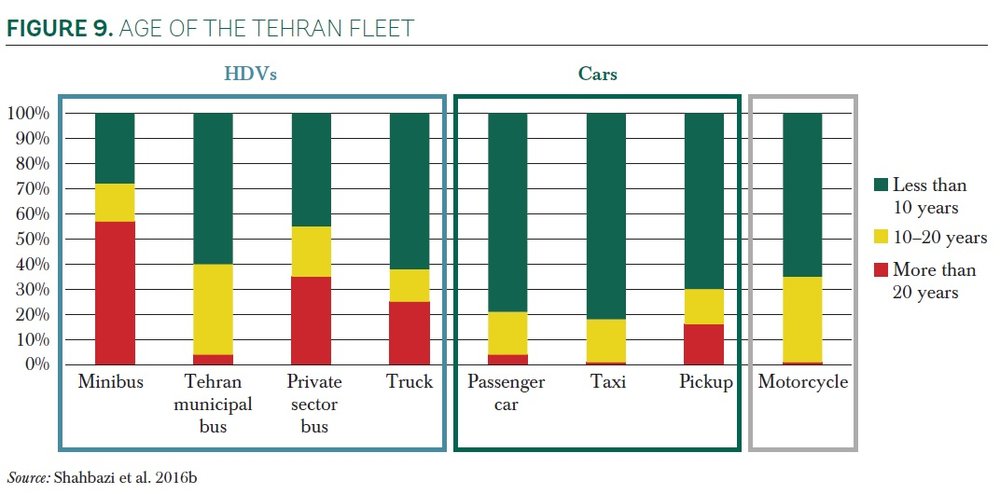
The age of heavy-duty vehicles is to blame for their substantial contribution to PM air pollution. On average, 30 percent of heavy-duty vehicles are more than 20 years old, with almost 60 percent of minibuses being more than 20 years old.
Iran introduced Euro 1 standards in 2003, Euro 2 standards in 2005, and Euro 4 standards in 2014. Even though Euro 4 was introduced, the heavy-duty vehicles fleet in Tehran is still largely meeting Euro 3 standards or less. In fact, the majority of vehicles only meet the Euro 1 standard. At Euro 3 standard and lower, there is no requirement for after-treatment technology in the exhaust. As such, all of Tehran’s heavy-duty vehicles diesel fleet consists of vehicle that have received no after-treatment technologies such as diesel particulate filters (DPF), selective catalytic reduction (SCR), and diesel oxidation catalyst (DOC).
In 2015, the government increased the emission standards for heavy-duty diesel vehicles to Euro 4, including the use of DPF technology. Euro 4 requires engines to use diesel fuel containing less than 50 parts per million (ppm) of sulfur, which is not widely avail- able in the country.
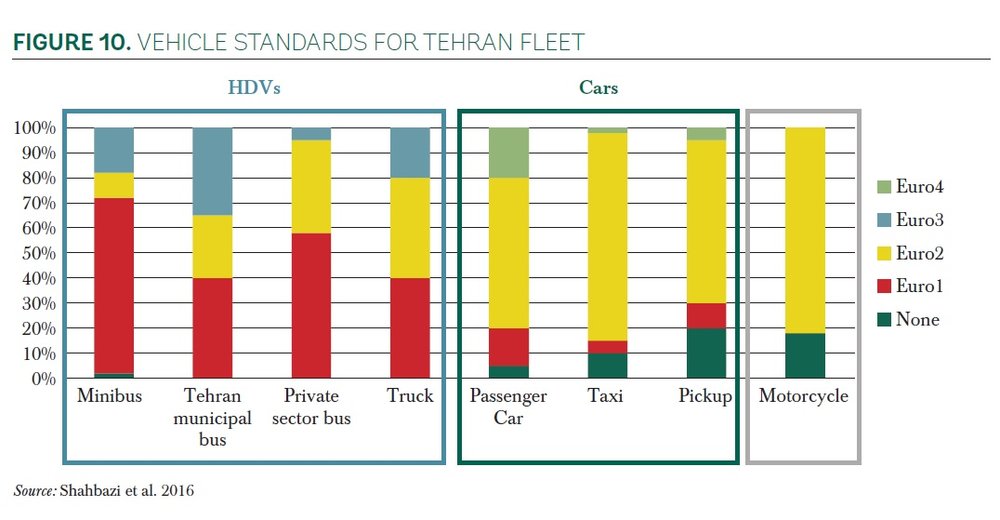
Motorcycles are the second largest contributor to PM, even before cars. One of the main reasons for their high contribution to emissions is that a large part of the fuel consumed in motorcycles burns incompletely. The Tehran motorcycle fleet consists mostly of carburetor-equipped motorcycles which are typically less fuel efficient and emit more emissions compared to newer, fuel injection technology.
In Tehran, 22 percent of pick-ups, 9 percent of passenger cars, and 5 percent of taxis have carburetor engines, which produce significantly more emissions than the newer technological alternative, fuel injection, because they need more fuel and are less efficient in using a unit of fuel. While only 9 percent of passenger cars are carburetor-equipped, they contribute to 51 percent of total emission from passenger cars. If these vehicles were to be replaced with Euro 4 vehicles, emission levels would drop significantly
How to reduce air pollution in Tehran
The government has managed to reduce air pollution in Tehran in recent years by adopting rules and regulations regarding age of the vehicle fleet, improve vehicle technology, introducing low emission zones (LEZs) in large cities by municipality; prohibiting the production and import of carburetors gasoline motorcycles, etc.

A multitude of policy measures are responsible for air quality improvements, including: adopting higher fuel quality standards (Euro 4); improving traffic management to reduce congestion in the downtown area; achieving the largest natural gas vehicle fleet in the world; improving public transportation (BRT and metro); and slashing fuel subsidies.
The number of unhealthy days decreased by about half, from 216 days in 2011 to 111 days in 2015, avoiding premature deaths, morbidity and productivity losses, and ultimately saved Tehran’s economy roughly half a billion dollar per annum.
Moving forward, the government and the municipality of Tehran may choose to take further measures towards reducing air pollution. Certain measures, including: replacement and scrappage programs for older heavy-duty vehicles; a comprehensive DPF retrofit program; improvement of vehicle monitoring and inspection; and ensuring enforcement and compliance with latest fuel standards are high on the list of policies that will do the job effectively and efficiently.
Moreover, the expansion of the LEZs to charge vehicles based on vehicle technology and emission standards, and to include motorcycles, would be another important step in the right direction. Finally, investing more in the expansion of the public transportation system should bring Tehran closer to clean air.
MQ/MG
Leave a Comment